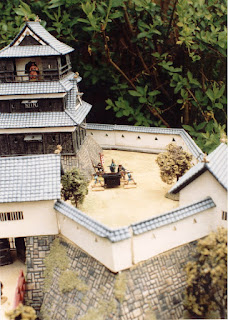All wargamers have a "lead mountain", some call it the "pile of shame", comprising all the stuff we bought but haven't yet got around to making presentable. I've got boxfuls of unpainted figures as much as any of you, but I feel I've also got a "photo mountain" that I need to transform into blog posts. So I will crack on, in this case with the earliest of my models which I have images of: the samurai castle.
In 1983 feudal Japan was about my biggest wargame interest, largely inspired by the Kurosawa film "Kagemusha". I had to have a castle on a stone-clad-mound to fight over. How hard could it be to build one? Well it took me a year, on and off. And it's by no means up to my later standards. And I've been trying unsuccessfully to protect the fragile material from damage for almost 40 years now. But it was satisfying to end up with a recognisable model that was functional enough for the sieges and ninja attacks that were played over it. The only way to learn and get better is to have a go, consolidate what comes out well and re-think what's not so successful.
The upper walls and the large mound were made from mounting card, with balsa serving for the wooden parts. But the lower walls and roofs were made out of sheets of plaster, cast in moulds by a firm called Linka. It was fun doing the casting, but the result is terribly vulnerable to knocks and chipping, as you can see in some of these photos.
Update: Going through my old folders I found some more nice photographs of this model. As viewers liked it, I thought I'd add them to this post by way of an update. They are at the bottom if you scroll down. (JB 20th November)










Wonderful to examine all of the photographs of your work here. Thank you! Might you consider adding a 'Follow' button to your blog though?
ReplyDeleteBest Regards,
Stokes
Thankyou. I did add a "Follow" button after about the first post. It's in the right-hand column, below the pictures of followers. Do say if you can't see it or anything.
DeleteJohn - you are going to think I am exaggerating - but I honestly scrolled through the four images and thought "why has he not put on any pics of his model?" Then I looked more closely and realised these are not, as I had imagined, stills from the film or examples of the real castle you were trying to replicate - this is really outstanding! To me, its the little details, like the trees in the foreground of the first image, that made me assume this was a picture of a real building. I remember Linka too - my dad had the moulds for his model railway and I kept them for years - they may still be at the bottom of a drawer or box in the garage somewhere!
ReplyDeleteI do think you're exaggerating, but thanks anyway. The trees are there precisely to camouflage the basic standard of work. I remember Linka coming along in 1978 and bought the various accessories that followed. It did help get me making model buildings, but large sheets were fragile and the casting plaster was horrendously messy to use!
ReplyDeleteGotta agree with Keith above, it does actually look real. Fantastic modelling John.
ReplyDeleteSecond pic looks totally real.
ReplyDeleteThanks for your kind comments, guys. To me this looks a bit of a dowdy model by my later standards, so it makes me wonder why it is evidently making such a positive impression on some folks. I think the answer is that we mostly see models (and certainly wargames figures) photographed by indoor lighting. However well set up it may be, I am of the opinion that building/ terrain models are better photographed outdoors. Natural daylight just falls on a model with a strength and at an angle that convinces many viewers they are seeing something real.
ReplyDeleteIt's interesting you perceive this, because I'm not sure everyone does the same. I have been having a scholarly debate with my friend Phil Olley about this, who of course helped me to set up this blog and knows a lot about photographing wargames stuff. Phil feels that things are better photographed with well-arranged, strong indoor photographic lights, as that way you can avoid shadows, which he sees as distracting. I think that is probably true for figures, wargames units or photos of a game, but for buildings/ terrain natural daylight is more persuasive, because strong light and shadow is what real sunlight looks like. I am encouraged to hear that I am not alone in this perception.
Once I have got all my older stuff posted ( few weeks now?), I am going to have to once again learn how to take pictures of my newer models, which I haven't done for many a year. I think there might be a role for both approaches.
John I like making scratch built buildings too and strongly agree that a sunny day outdoors with an appropriate background brings out the best in one's model buildings
ReplyDelete